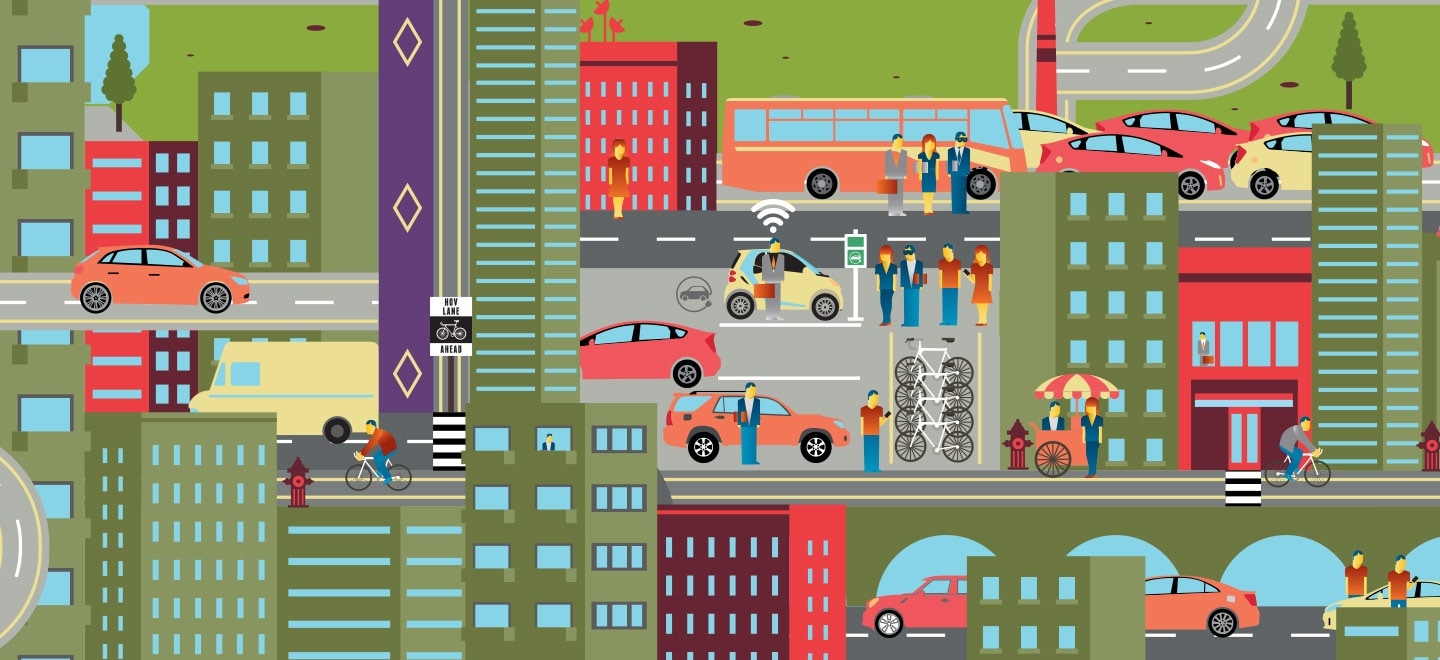The promise of smart mobility has been saved

The promise of smart mobility Part of the "Smart mobility" research report
19 May 2015
Emerging alternatives to traditional car ownership—including ridesharing, carsharing, bike commuting, and on-demand ride services—can not only get people where they want to go, but also help address public policy problems such as congestion, traffic accidents, and air pollution.
The promise of smart mobility
Explore
Visit the Future of Mobility collection
Watch a video of Ben's journey
Listen to the podcast
Subscribe to receive updates on Future of Mobility
Explore Deloitte Review, issue 20
New business models inspired by the sharing economy and disruptive technologies are ushering in an exciting new age in transportation: the era of smart mobility. The arrival of on-demand ride services like Uber and Lyft, real-time ridesharing services such as Carma and Zimride, carsharing programs such as Zipcar and car2go, bike sharing programs, and thousands of miles of new urban bike lanes are all changing how people get around.
Commuters no longer need to own a car to have one at their disposal. They don’t have to pre-arrange carpools to share a ride with others headed in the same direction. They needn’t wait for a ride home when it’s pouring down rain and there’s not an empty cab in sight.
For their part, automakers increasingly see themselves as both product manufacturers and mobility services companies. In addition to developing next-generation connected and autonomous vehicles that will improve traffic flows and safety, automakers are investing in a wide swath of new mobility services—everything from carsharing and rental services to multimodal trip-planning apps.
There’s no question that consumers have been the primary beneficiaries of new mobility services. The question facing urban planners is how today’s expanded mobility ecosystem can help advance public policy goals such as encouraging higher productivity and reducing congestion, while bringing related benefits such as fewer traffic accidents, better air quality, and a smaller urban footprint for parking.
Can alternative transportation modes help metropolitan areas reduce traffic congestion without spending tens of billions of dollars on new roads, tunnels, and light rail? And if so, what are the most promising strategies? Which approaches work best in which cities? How can automakers and transportation officials work together to address changing mobility needs?
These are just a few of the questions our analysis attempts to answer.
This study takes a data-driven look at what metropolitan areas can gain from expanded mobility ecosystems. We compare alternative approaches from ridesharing to biking, and explore how governments can focus scarce investment dollars on areas where they can do the most good.
Traffic congestion in America: Grim and getting worse
The need for answers to America’s traffic gridlock problem becomes more acute each year. In much of the nation, traffic congestion has increased to alarming levels, with associated costs estimated at $121 billion, equivalent to slightly more than 1 percent of all annual US personal consumption.1
The average American spends about 34 hours every year sitting in traffic. That’s a whopping 5.5 billion hours for all commuters.2 The economic opportunity cost is staggering: $330 million daily, or about $124 billion every year. If nothing changes, this cost could grow to $186 billion by 2030.3
And that’s just the cost to individuals. Every mile we drive costs governments 7.5 cents, and at almost 3 trillion vehicle-miles traveled per year, those miles add up.4 If you include the cost of congestion, air pollution, or even lost property value near roadways, the total estimated external cost of driving runs between 27 cents and 55 cents per mile.5
For decades, governments have tried in vain to develop solutions to address congestion. High-occupancy vehicle (HOV) lanes and costly public transportation networks may have slowed the growth of congestion, but commute times continue to lengthen in America’s urban centers. Estimates suggest that only 15 percent in congestion savings can be achieved even with widespread deployment of such conventional measures to all major freeways.6
Clearly, a new approach is needed.
Nurturing the elements of smart mobility ecosystems
Helsinki, Finland has announced an audacious goal: By 2025, the city plans to make it unnecessary for any city resident to own a private car. The goal is an on-demand mobility system that would allow customers to choose among public and private transport providers and assemble the fastest or cheapest way of getting anywhere they need to go at any time.
“The city’s role is to enable that market to emerge,” explains Sonja Heikkilä, a transportation engineer with the city.7
Bus routes would be dynamic, changing based on current demand at any moment. From planning to payment, every element of the system would be accessible through mobile devices.8
Citizens could arrange a personalized travel experience irrespective of location. Wherever they are in the city, they could access a variety of options with their phone: a rideshare, an on-demand bus, an automated car, special transport for children, or traditional public transit. Residents could purchase “mobility packages” from private operators that would give them a host of options depending on weather, time of day, and demand.
Today, our congested transportation system is designed around infrastructure and vehicles: roads, bridges, subways, and buses. Helsinki’s 2025 vision points to a very different future model, one designed around individual mobility—moving each traveler from point A to point B as quickly and efficiently as possible. US cities also are beginning to reimagine their transportation ecosystems around this concept.
A transportation system designed around individual mobility would prominently feature four modes of alternative mobility (as well as more traditional modes such as buses):
- Ridesharing (i.e., carpooling), which taps into an abundant yet underutilized resource: empty car seats. This option doesn’t add any new vehicles to the system, and that’s why it could help reduce the traffic congestion that plagues most cities today. Unfortunately, carpooling has declined from around 20 percent of all commuters in 1970 to less than 10 percent today.9
- Bicycle commuting, which has been on the upswing in recent years, particularly in Europe and in cities with relatively flat terrain, miles of bike lanes, and other cycling infrastructure. For commutes of a few miles or less, biking is often the fastest way to get to work.10
- Carsharing, enabled by new technology that allows companies and individuals to rent cars by the minute or hour.
- On-demand ride services companies such as Uber and Lyft, which allow ordinary motorists to use their personal cars to offer prearranged transportation services. These services, enabled by mobile and GPS technologies, are making the taxi market more competitive.
See appendix A for a more detailed definition and description of each mode.
 These forms of transportation have seen different levels of popularity in recent years. Ridesharing, as mentioned above, has been in decline for decades. On-demand ride services, on the other hand, have seen rapid growth since their launch several years ago.
These forms of transportation have seen different levels of popularity in recent years. Ridesharing, as mentioned above, has been in decline for decades. On-demand ride services, on the other hand, have seen rapid growth since their launch several years ago.
Individual, corporate, and government incentives line up well for some of these modes, and poorly for others. Where the incentives align, we see faster growth (figure 1). Ridesharing, for example, suffers from a lack of both individual incentives to participate and private sector incentives for technological innovation. Carsharing’s growth has been more rapid due in part to automobile manufacturers’ entry into the carsharing business and relatively enthusiastic support from municipalities.
We now take a more detailed look at the current and future role that each of the four transport modes can play in addressing America’s traffic congestion problems.
Our methodology
To understand which cities—and even neighborhoods—stand to gain the most from better congestion reduction strategies, we examined a variety of data, most prominently commuter behavior at the census-tract level. Using data from the Census Bureau’s American Community Survey (ACS) and Census Transportation Planning Products (CTPP), we estimated the number of people who could reasonably rideshare or bike to work.11 We then tallied up how many vehicle miles traveled (VMT) and congestion-cost dollars would be saved if all of these commuters used alternative transportation.12
For carsharing, we used a slightly different approach. Using ACS data, we estimated the population in each tract matching the target demographics of carsharers.13 With these numbers, we estimated the number of neighborhoods nationwide with strong carsharing potential.14
On-demand ride services, the newest of the alternative transportation modes we studied, also offers the least available data.15 Our estimates for this mode are thus less detailed.
For each mode, we compare current usage rates with estimates representing our model’s maximum possible usage.
A more detailed description of our methodology for capturing the existing and potential reach of alternative mobility approaches can be found in appendix B.
Explore our collection of research on smart mobility at the links below.
- Key findings from the smart mobility study
- The promise of smart mobility
- Ridesharing
- Bike commuting
- Carsharing
- On-demand ride services
- Alternative transportation atlas (interactive map)
- Impact by metropolitan area (interactive table)
- FULL REPORT—Smart mobility: Reducing congestion and fostering faster, greener, and cheaper transportation options






